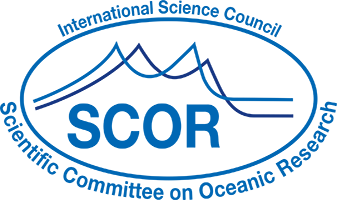News
+ more news
An Internally Consistent Dataset of δ13C-DIC Data in the North Atlantic Ocean
Thursday, 03 March 2016
We would like to let you know that An Internally Consistent Dataset of δ13C-DIC Data in the North Atlantic Ocean (NAC13v1) is now available for download from CDIAC. The dataset has undergone strict quality control. It includes all in all 6068 samples, originating from oceanographic research cruises that took place between 1981 and 2012. The dataset by Becker et al. is currently under review for publishing in Earth System Science Data (ESSD).

Gordon Research Conference on Ocean Biogeochemistry, Hong Kong, China, 12-17 June 2016
Monday, 29 February 2016
Application for the 1st Gordon Research Conference (GRC) on Ocean Biogeochemistry is now open. The conference will be held at the Chinese University of Hong Kong on 12-17 June 2016. The topic will be The Biologically-Driven Ocean Carbon Pumps.
The deadline for submitting online applications is May 15, 2016.

2016 Call for SCOR Working Group Proposals
Wednesday, 17 February 2016
The Scientific Committee on Oceanic Research (SCOR) is accepting proposals for 2016 SCOR Working Groups from now until 17 April 2016. SCOR will approve new working groups at its annual meeting, this year held in Sopot, Poland on 5-7 September 2016.

The 2016 POGO-SCOR Visiting Fellowships programme is now open for applications
Tuesday, 09 February 2016
The Partnership for Observations of the Global Oceans (POGO) and the Scientific Committee on Oceanic Research (SCOR) are jointly funding a Visiting Fellowships programme designed to promote training and capacity building leading towards a global observation scheme for the oceans. The Programme has been a success for over fifteen years, with over 160 fellowships awarded since 2001. The fellowship programme is open to scientists, technicians, graduate students (preferably PhD) and post-doctoral fellows involved in oceanographic work at centres in developing countries and countries with economies in transition.
The deadline for the applications for this year is 15th April 2016.

MARIANDA Training Workshop in Kiel, Germany, Spring 2016
Tuesday, 09 February 2016
We would like to inform you that MARIANDA prepares a training workshop for alkalinity and dissolved inorganic carbon (DIC) measurements in sea water. The workshop will be held on April 25-29, 2016 in Kiel, Germany. The planning of the workshop is in its initial stage and we appreciate any feedback and suggestions.

Marine Chemistry Special Issue: Cycles of metals and carbon in the oceans - A tribute to the work stimulated by Hein de Baar
Monday, 08 February 2016
A very interesting compilation of articles on topics ranging from photo-oxidation and changes in nutrient distributions, to drivers of seasonality of CO2 and its fluxes in the Southern Ocean, published in Marine Chemistry Special Issue: Cycles of metals and carbon in the oceans – A tribute to the work stimulated by Hein de Baar, available here.

International consultation confirms EU’s crucial role in ocean governance
Friday, 05 February 2016
We are pleased to let you know that the EU Commissioner for Environment, Maritime Affairs and Fisheries, Karmenu Vella, announced today the results of the Commission's public consultation on international ocean governance at the SeaWeb Seafood Summit in Malta.

Colour and Light in the Ocean from Earth Observation (CLEO) Workshop, 6-8 September 2016, Frascati, Italy
Friday, 05 February 2016
We would like to inform you that the Colour and Light in the Ocean from Earth Observation (CLEO) workshop: Relevance and Applications Products from Space and Perspectives from Models, co-organized by the European Space Agency (ESA) and the Plymouth Marine Laboratory (PML), will be held on 6-8 September 2016 in ESA’s Centre for Earth Observation (ESRIN) in Frascati, Italy.
Abstract submissions are open until 15 June 2016.

NATO commits its vessel to climate monitoring program
Thursday, 28 January 2016
A multinational observation network PIRATA (Prediction and Research Moored Array in the Tropical Atlantic) has just gained support from the North Atlantic Treaty Organization (NATO) Research Vessel (NRV) Alliance to accomplish studies, monitoring and maintenance requirements of this essential climate monitoring program. A five-year framework agreement between NATO Centre for Maritime Research and Experimentation (CMRE) and the National Oceanic and Atmospheric Administration (NOAA), signed in December 2015, marks a breakthrough in transatlantic cooperation while fostering sharing of assets and capabilities in oceanic and atmospheric monitoring in the North Atlantic.

Third IOCCG Summer Lecture Series: “Frontiers in Ocean Optics and Ocean Colour Science”, Villefranche-sur-Mer, France, 18- 30 July 2016
Monday, 25 January 2016
The third International Ocean-Colour Coordinating Group (IOCCG) Summer Lecture Series, dedicated to high-level training in the fundamentals of ocean optics, bio-optics and ocean colour remote sensing will take place at the Laboratoire d’Océanographie de Villefranche (LOV), in Villefranche-sur-Mer, France from 18 to 30 July 2016. Participation is restricted to 20 students and is highly competitive.
Application Deadline: 15 March 2016 (strictly enforced)!
The IOCCP promotes the development of a global network of ocean carbon observations for research through technical coordination and communication services, international agreements on standards and methods, and advocacy and links to the global observing systems. The IOCCP is co-sponsored by the Scientific Committee on Oceanic Research and the Intergovernmental Oceanographic Commission of UNESCO. Read more…
Calendar
|
|
IOCCP meetings, IOCCP-related meetings as well as events related to a wider scope in marine biogeochemistry. |





 Please wait...
Please wait...